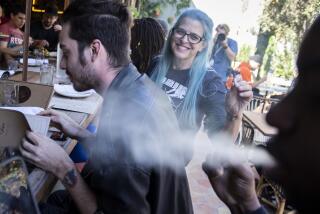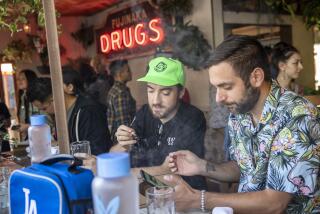Butting Out in the Big Apple : Lifestyles: Even New York eateries are telling smokers to stop. There goes the city’s hardscrabble image. What’s next, red meat?
- Share via
NEW YORK — You can’t have a cigarette after dinner anymore in New York City restaurants. Surprised? Probably not. It’s happening everywhere--Utah, Vermont, Aspen, Austin, even Chicopee, Mass., and a hundred other cities nationwide, so why not Gotham?
There is this illusion about New York. That it’s different. It’s one thing to be smoke-free in Los Angeles, where the illusion of life is clean and healthy. But life here is supposed to be dangerous; at every moment people calibrate their chances.
So why should smokers, even if they are the minority and knowingly chance cancer, be denied a smoke after a big meal or at the coffee-shop counter in the morning with their tabloid?
Adam Tihany, a restaurateur with a foothold in both cities, advances these stereotypes, thank you very much: “California is the healthy state where if you smoke in the street people come up to you and give you their piece of mind,” says Tihany, a partner in Remi in Santa Monica and proprietor of Remi in Manhattan, both known for upscale Venetian fare. “But New York is more a city of the world, a sexy international place, and every time these laws come it loses its luster as an international capital.”
Yes, that is the image, Mr. Tihany, and perhaps it’s a little true just like it’s a little true that Paris is brilliantly sunny all the time. (Fact is, Paris is often as dismal and rainy as London.)
“I’m telling you,” says Tihany, stoking the imagery, “steak and red wine are next!”
On April 10 the New York City Council banished smokers to the bar, and then only if the bar is six feet from the dining room, and then only if there is a separate waiting area. Only restaurants that seat less than 35 people were exempted, or places with outside tables if there’s a special section that is no more than one-fourth of the total outdoor area. (The California law is simpler: It bans smoking in all restaurants, no matter how small, but allows unlimited smoking outdoors and at the end of 1996 will shut smokers out of bars.)
“A bus on Broadway can belch black smoke in my face but you better not blow cigarette smoke my way: Does that make sense?” snaps Barri Rosen, a disgruntled smoker sulking on a sunny afternoon at an Upper West Side outdoor cafe.
“Don’t mind her, she’s a grouch,” says her nonsmoking partner, Leslie Baron, a native Californian. “She can live--underline live --without a cigarette at lunch.”
But wait. This is sounding way too negative. In fact, most New Yorkers apparently are not grousing. Restaurateurs, including Tihany, say they’re hearing less from the moaners and more from relieved patrons annoyed when smoke got in their eyes. And who’s to say this is going to harm business for the 16,000 restaurants in the five boroughs as owners had feared? Executives of the airlines and trains went ballistic when they faced prohibition and didn’t they survive?
“We can’t be sure yet of anything--it’s too soon,” says Fred Sampson, head of the New York City Restaurant Assn. The trade group has pledged to watch profits, and if business falls more than 6% they’ll be calling New York City Council President Peter Vallone, a key proponent of the new law.
“We’re mostly worried about the bridge and tunnel crowd,” says Sampson, using local-talk to describe people from New Jersey, Long Island and Westchester County. “If we lose those customers, the owners will go to the wall.”
For now, Elaine Kaufman, who has run the celebrity-watching Elaine’s on the Upper East Side for the past 32 years, is reconciled to the law. “I know enough not to fight City Hall,” says Kaufman, leaning against her bar with a plastic cigarette hanging out of her mouth. Kaufman, who is trying to cut down on smoking, doesn’t think the restrictions will get her or any other smokers unhooked.
But that’s not really the point.
The man who arm-twisted City Hall into this new legislation doesn’t particularly care what it does for smokers. Nor does he like the Big Brother label pinned on him by the “tobacco cartel.”
“Let them smoke four packs a day,” says Joseph W. Cherner, head of the SmokeFree Educational Services Inc., a group he founded and personally financed. “I’m worried about waiters and waitresses doing 10-hour shifts. Nobody should be forced to breathe smoke to hold a job.”
*
Cherner is emblematic of how New York puts its own twist on an issue. Most grass-roots groups like Cherner’s are driven by people who have seen family members die of lung cancer or people with the energy to fight the tobacco industry while trying to work.
Joe Cherner, on the other hand, is a former Wall Street bond trader. After cleaning up on deals in the late 1980s, he decided to take a one-year leave from Kidder Peabody to try to “do something good, something meaningful, like reduce cancer in the next generation of New Yorkers.”
Unfortunately for the tobacco industry and mercifully for an estimated 70% of nonsmoking New Yorkers, Cherner, 37, started a one-man crusade. He is why smoking is banned in city schools, Yankee and Shea stadiums, and most offices. (Like other agitators for tougher anti-smoking laws across the country, his efforts gained momentum after January, 1993, when the federal Environmental Protection Agency declared secondhand smoke a significant contributor to cancer and recommended employers minimize their employees’ contact with tobacco smoke.)
Philip Morris is so furious over the New York City law that it has threatened to close its Park Avenue headquarters and move out of town along with its $10 million in corporate contributions to the arts.
“It is becoming difficult to justify remaining in a city that is so inhospitable to us,” says Ellen Merlo, a senior vice president for Philip Morris. “We’re at the point where we’re considering all our options.”
The previous law that allowed restaurants to create smoking sections allowed people with different needs to coexist, she says. “How much of a nanny state have we become?” she adds. “Do we really base New York on what California does? California has always been a little bit out on the fringe.”
Yet the consensus against smoking is apparent on both coasts.
Last September, the Zagat organization, which puts out restaurant guides, asked 18,223 people whether smoking should be banned in restaurants. In Los Angeles, 81% said yes; in San Francisco, 80%, and in New York, 69%.
*
Whether the law in New York will be enforced is another story.
Already a lot of celebrities, such as CBS commentator Charles Kuralt and patrons of the chic restaurant in the Royalton, have been quoted as saying they’ll pay up to $1,000 fines rather than quit smoking at their favorite hangouts.
And higher profile restaurants among Manhattan’s 7,000 eateries seem to be resisting, if you believe a survey done by New York Post reporters. They visited 100 restaurants and found that 61 were not adhering to the letter of the law: There were ashtrays around and waiters winked a lot when patrons asked if they could smoke.
At 7:30 on the morning the law went into effect, city health inspectors were knocking at the door of Drake’s Drum, a hamburger and beer joint a few blocks from Elaine’s on Second Avenue.
The father-and-son owners, James and Ian Duke, had received a lot of publicity for coming up with the novel idea of creating a “smokeasy”--a bar that caters to smokers and harks back to the 1920s Prohibition and speak-easies. The Dukes removed half the seats leaving 34, added some couches, changed their menu and put in a $40,000 ventilation system so their smoking patrons don’t come away smelling like a chimney.
“It’s a gimmick,” says 24-year-old Ian, lighting up a Marlboro for a photographer. “But it’s also a risk. This could put us under.”
More to Read
Sign up for The Wild
We’ll help you find the best places to hike, bike and run, as well as the perfect silent spots for meditation and yoga.
You may occasionally receive promotional content from the Los Angeles Times.






